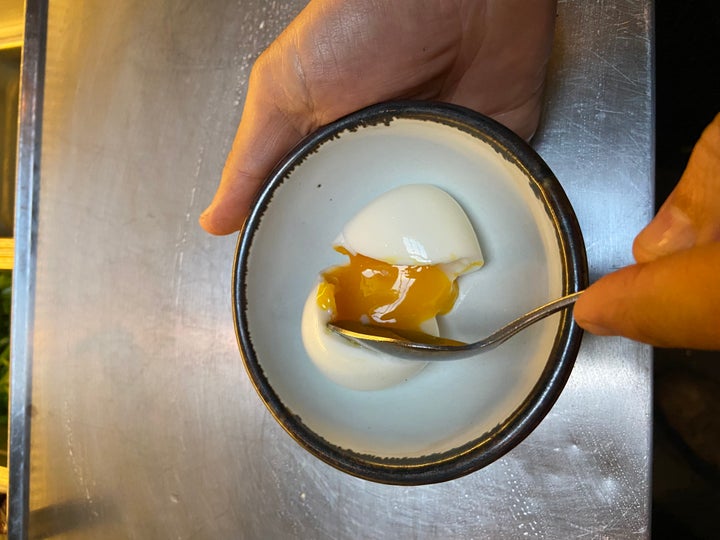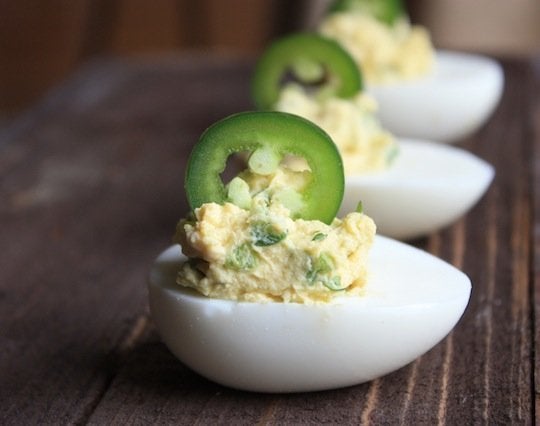An enduring kitchen staple, eggs are particularly useful to have on hand during the coronavirus pandemic due to their health benefits and versatility. There are a variety of classic preparations for those looking to make a quick breakfast or amp up a lunch or dinner plate –– sunny side up, scrambled, hard-boiled and poached, to name a few.
But for those looking to mix things up, we’re here to tell you about the magic that is jammy eggs.
“This is my favorite form of egg,” Sara Woods, executive chef at Vaux, a contemporary restaurant in Portland, Oregon, told HuffPost. “Granted, I will also say that about several other styles of egg cookery, but I really like eggs. A jammy egg, where the white is completely set and solid but the yolk is still creamy and soft, is really the ideal combination of all egg qualities. No snotty whites, no gray chalky yolks. Just all parts of the egg in their optimum form.”
Celebrity chef, television personality and cookbook author Lidia Bastianich defines jammy eggs as having solid egg whites and yolks “cooked to a spreadable texture.” Think somewhere between a soft-boiled and a hard-boiled egg.
There are many ways to achieve this texture. Here’s how:
The boil method
Nick Korbee, partner at Egg Shop, an egg-centric cafe with two locations in New York City, makes jammy eggs by carefully lowering whole eggs into rapidly boiling water that’s salted and slightly acidulated. “Enough water to cover the eggs by one inch, plus two tablespoons vinegar and two teaspoons salt,” Korbee said. “Boil for 7 minutes and 30 seconds and immediately remove eggs and place in an ice bath. Peel and enjoy when they’re just cool enough to handle comfortably.”
The addition of salt and vinegar to the water is Korbee’s “superstitious trick that seems to make the eggs easier to peel.”
Woods similarly lowers whole eggs into boiling water. However she cooks them for 6 1/2 minutes before cooling in ice water.
Bastianich places room temperature eggs in a pot of boiling water for approximately 7 minutes, “give or take a minute, depending on how runny you want your egg yolks.”
There may be some trial and error to determine the optimal cooking time for your eggs at home, as size and other factors (like the number of eggs you’re boiling at once) can affect cook time.

Matthew Accarrino, executive chef at SPQR, a Michelin-starred Italian restaurant in San Francisco, recommends removing eggs from the refrigerator and letting them sit on the counter at room temperature for about 15 minutes as the water heats up, so that “the eggs are at equal temperature and all cook uniformly.” He makes sure to have enough water in the pot to cover the eggs by at least two inches. “If there is not enough water, then once you put the eggs in the temperature has to rise back up and you lose some of your cooking time,” Accarrino said. “My benchmark is a 6-minute egg. This gets you a set white with a custardy yolk.”
The immersion circulator method
While Woods uses the boil method for making jammy eggs most days, “If I’m feeling fancy, I’ll bust out the immersion circulator and cook the whole eggs, in the shell, at 194 degrees Fahrenheit for 8 minutes.” No vacuum sealer required ― just place the eggs in the temperature-controlled water bath. Once the eggs are finished cooking, Woods places them in an ice bath or runs them under cold water before peeling.
The steam method
Whether he’s using the popular boil method or steaming his eggs, Accarrino brings water to a simmer (approximately 200 degrees Fahrenheit). While he ensures there is plenty of water in the pot when boiling eggs, the steaming method requires less water.
“You can steam eggs in a basket, like an artichoke,” Accarrino said. He brings his water to a simmer, places a steamer basket over the water and steams the eggs for the same amount of time he would boil them (which in his case is 6 minutes). Like the boil method, after cooking, the steamed eggs are placed in cold water to stop them from cooking any further.
How to peel jammy eggs
To peel jammy eggs, Accarrino has two methods: place the eggs in a covered container with water and shake them, or tap the bottom of the egg on the counter and work your way around to peel it completely. “There is an air pocket there and the membrane is thinner,” he said.
Ways to enjoy jammy eggs
While there is no right or wrong way to eat jammy eggs, our chef experts have shared their go-to preparations to help get you started.
Korbee enjoys cured and marinated jammy eggs “where the peeled eggs are soaked in a variety of brining liquids.” He uses excess pickling liquid from beets or red onions to make bright pink eggs, covering the eggs with the brine and allowing them to soak overnight or up to two days to achieve a more intense color.
Woods enjoys warm jammy eggs with buttery toast, as well as on top of a lunchtime salad. For a handy snack, she recommends keeping a couple unpeeled jammy eggs in your fridge and, when you’re hungry, simply peeling them, halving and sprinkling with your favorite seasoning blend (think flake salt, furikake, harissa, etc.).
Accarrino noted that jammy eggs are great on a Caesar salad, as well as covered in breadcrumbs and fried, like a Scotch egg.
For breakfast, Bastianich sprinkles crispy bacon bits on jammy eggs. “Jammy eggs are good with most steamed or boiled vegetables such as leeks, asparagus or broccoli drizzled with olive oil and a squeeze of lemon juice or wine vinegar,” she said. “These combinations make a balanced lunch or dinner.”
